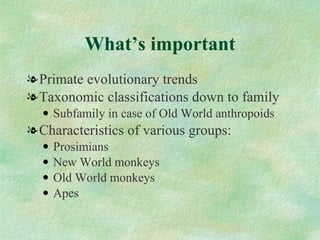233 what are primates
- 1. Whatâs important Primate evolutionary trends Taxonomic classifications down to family Subfamily in case of Old World anthropoids Characteristics of various groups: Prosimians New World monkeys Old World monkeys Apes
- 2. PRIMATE TAXONOMY AND CHARACTERISTICS
- 3. Suborder Infraorder Superfamily Family Infraorder:-formes; Superfamily:-oidea; Family:-idae; Subfamily:-inae, and Parvorder & tribe:âini (Strepsirhini) Prosimians
- 4. Catarrhini Suborder: Anthropoidea (Haplorrhini â dry/simple-nosed primates â includes tarsiers) Infraorder: Simiiformes Parvorder: Catarrhini
- 5. EVOLUTIONARY TRENDS NAPIER AND NAPIER LE GROS CLARK
- 6. Generalized/unspecialized skeleton allows varied locomotion
- 7. Pentadactyly, prehensility, opposability, nails, tactile pads
- 8. Reduction of snout/muzzle and olfaction
- 9. Increased visual acuity, color perception, binocular and stereoscopic vision
- 10. Generalized dentition/diet Dental formula
- 11. Increased complexity of brain, especially cerebral cortex Increase in efficiency of prenatal fetal nourishment Tendency toward upright posture Capable of bipedalism at least for short periods Long pre- and postnatal life periods with greater reliance on learned behavior Tendency toward diurnality
- 12. PROSIMIANS
- 13. Suborder Infraorder Superfamily Family
- 14. Ėý
- 15. Ėý
- 16. PROCUMBENT INCISORS / DENTAL COMB
- 17. Tendency toward VCL
- 18. More pronounced muzzle Higher reliance on olfaction Scent marking Mulitple scent glands Moist rhinarium Immobile upper lip Inexpressive face Large laterally oriented eyes Most species nocturnal Tapetum lucidum Higher reliance on audition Mobile ears
- 19. Digits act together in power grip Multiple pairs of teats Frequent multiple births
- 20. TARSIERS
- 21. Ėý
- 22. Ėý
- 24. Ėý
- 25. PARVORDERS: Platyrrhini: rounded widely-spaced nostrils Catarrhini: narrow downward-facing nostrils
- 26. Ėý
- 27. ARBOREAL
- 28. Long tails norm Some prehensile
- 29. 2-1-3-3 dental formula Twinning in Callitrichines
- 30. Ėý
- 31. Catarrhini
- 32. Catarrhini (relative to Platyrrhini) 2-1-2-3 Expanded ischial tuberosities Larger-bodied (in general) More folivorous and terrestrial species More complex derived brain Nose
- 33. Ėý
- 34. OLD WORLD MONKEYS CERCOPITHECINES
- 35. OLD WORLD MONKEYS COLOBINES
- 36. Ėý
- 37. Evolutionarily successful / Taxonomically diverse More closely resemble earliest anthropoids than do apes Many have long tails and sexual swellings Ischial callosities Opposable thumbs except African colobines â thumbless (see left)
- 38. Ėý
- 39. Ėý
- 40. APES
- 41. Ėý
- 42. Ėý
- 43. Ėý
- 45. Ėý
- 46. LESSER APES
- 47. Relative to great apes Smaller Gracile skeleton More primitive but most specialized Monomorphic Shorter snouts Long canines â IMI Longer upper limbs/hands Long curved fingers, no thumb Strictly arboreal Ischial callosities Most lack sexual swellings
- 48. GREAT APES
- 49. Relative to lesser apes Less suspensory Varying degrees of terrestriality Build nests Larger-bodied Longer-lived Long developmental/dependency period Sexually dimorphic In captivity, symbolic behavior seen
















































